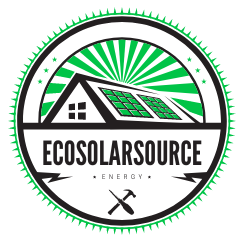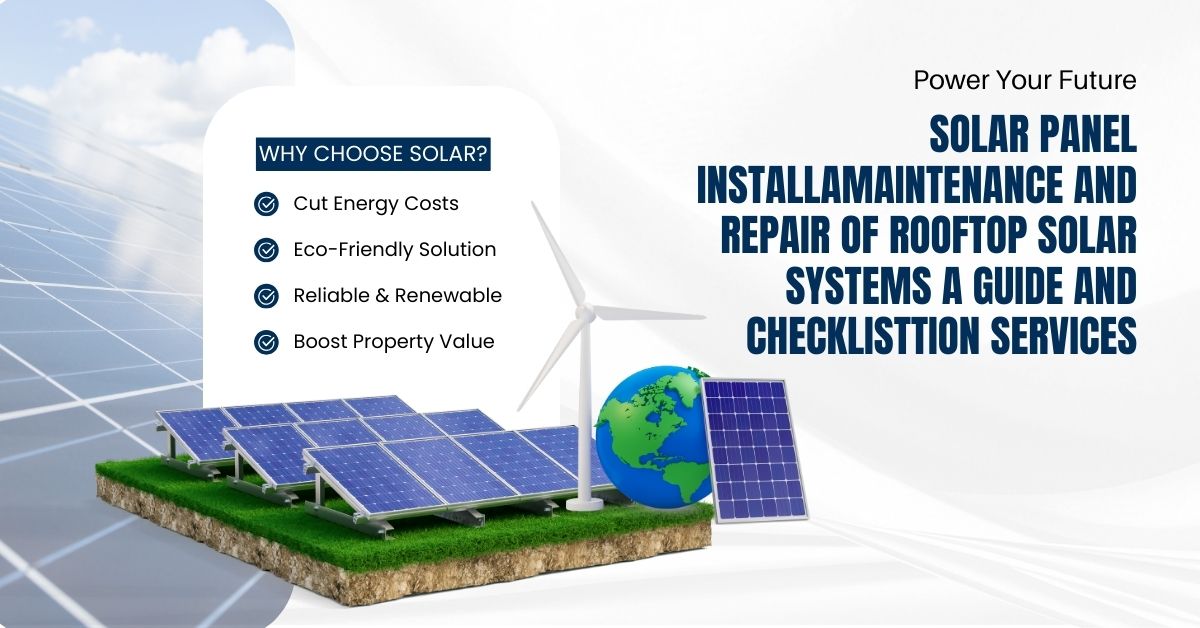Maintenance and Repair of Rooftop Solar Systems A Guide and Checklist
Know the details about Maintenance and Repair of Rooftop Solar Systems A Guide and Checklist, This comprehensive guide and checklist will help you learn the essentials of maintaining and repairing rooftop solar systems. From routine inspections to troubleshooting common issues, this guide covers everything you need to know to keep your solar panels functioning at peak performance.
Discover tips on panel cleaning, checking inverters, monitoring energy output, and identifying wear and tear to prolong system life. Whether you’re a homeowner or a technician, this resource simplifies solar maintenance to maximize efficiency, reduce repair costs, and enhance energy savings. Ensure your rooftop solar investment stays reliable and effective with our expert recommendations and practical steps.
Table of Contents
Maintenance and Repair of Rooftop Solar Systems A Guide and Checklist
As solar energy continues to grow in popularity, more homeowners and businesses are installing rooftop solar systems to generate clean and renewable energy. While solar panels are highly durable and require relatively little maintenance, they are not maintenance-free. Proper upkeep ensures that your investment remains efficient and productive for decades. In this comprehensive guide, we will delve into everything you need to know about maintaining and repairing rooftop solar systems. You’ll also find a detailed checklist to help streamline your maintenance process.
Why Maintenance of Solar Systems Is Important
Rooftop solar systems are exposed to the elements 24/7, making them vulnerable to dust, debris, weather conditions, and other environmental factors. Proper maintenance ensures that your system performs at its best, generating the maximum amount of energy possible. Additionally, routine care helps prevent potential breakdowns and prolongs the lifespan of the solar panels and associated components.
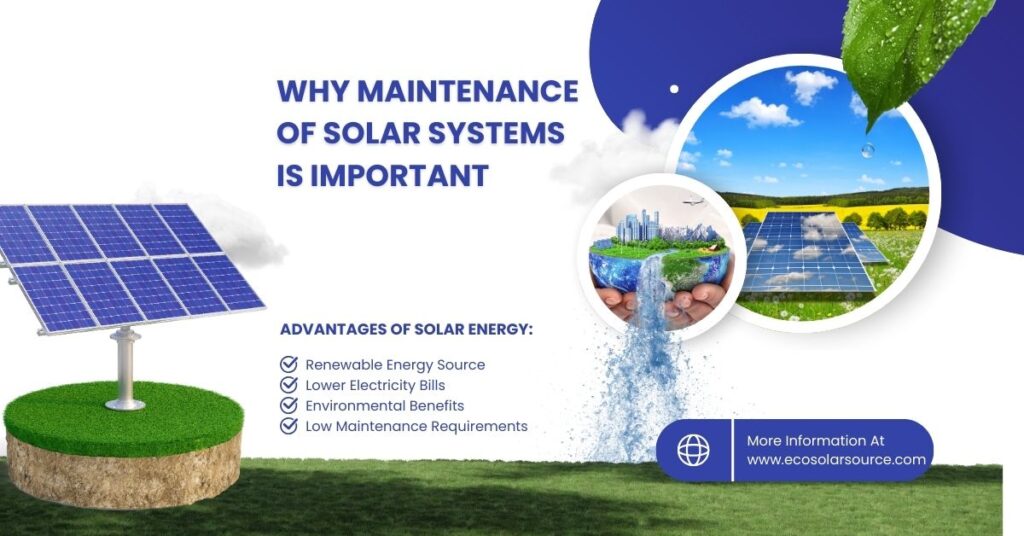
- Maximizing Energy Output: Over time, dust, dirt, and other particles can accumulate on the surface of your solar panels, blocking sunlight and reducing efficiency. Regular cleaning ensures that panels can absorb as much sunlight as possible, improving energy output.
- Preventing Major Repairs: Routine maintenance helps identify small issues before they develop into major problems. For example, detecting a loose wire early can prevent damage to the entire system. Repairing small issues promptly saves both time and money.
- Prolonging System Lifespan: A well-maintained solar system can last 25-30 years or longer. Without proper care, the components may degrade faster, requiring premature replacements or extensive repairs. Preventative measures ensure that your system functions optimally for decades.
- Ensuring Safety: Faulty components or electrical issues can pose a risk of fires or electrical hazards. Regular inspections ensure that your system is not only efficient but also safe.
Key Components of Rooftop Solar Systems
Before diving into maintenance tips and repairs, it’s essential to understand the key components of a rooftop solar system and how they work together. Each of these parts may require some level of attention during maintenance or repair.
- Solar Panels (Photovoltaic Panels): These panels absorb sunlight and convert it into electricity. Most residential solar panels are made of either monocrystalline or polycrystalline silicon.
- Inverter: The inverter converts the direct current (DC) produced by the solar panels into alternating current (AC), which is used by most household appliances.
- Mounting Systems: The panels are attached to your roof using a racking system, which should be strong and weather-resistant. These systems also keep the panels at the optimal angle to capture sunlight.
- Wiring and Electrical Components: A network of cables connects the solar panels to the inverter and then to your home’s electrical system. Proper wiring ensures efficient electricity flow.
- Battery Storage (Optional): For those who have solar batteries, these systems store excess energy produced during the day for use when solar generation is low (e.g., at night or during cloudy weather).
Common Maintenance Tasks for Rooftop Solar Systems
Although solar systems are designed to require minimal maintenance, there are certain tasks that homeowners or businesses should perform regularly to ensure optimal operation.
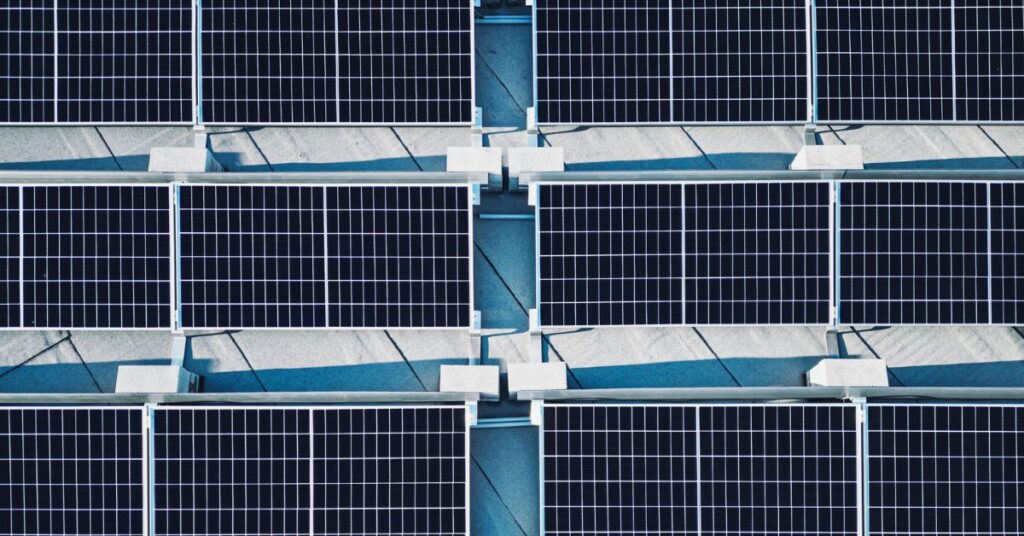
1. Cleaning the Solar Panels
Frequency: Every 6-12 months, depending on location
Why: Dust, dirt, bird droppings, leaves, and pollen can accumulate on solar panels, reducing their efficiency by blocking sunlight.
How:
- Use a soft brush or squeegee with an extendable handle to clean the panels.
- Use a gentle soap solution and water to wash off grime and dirt.
- Avoid using harsh chemicals, as they can damage the glass surface of the panels.
- For harder-to-reach panels, consider hiring a professional cleaning service.
2. Inspecting for Damage or Wear
Frequency: Every 3-6 months
Why: Solar panels are exposed to the elements and can be susceptible to damage from storms, hail, or falling debris. Over time, wiring or connections may loosen, or the racking system may weaken.
How:
- Visually inspect the panels for cracks, chips, or other damage.
- Check the wiring for signs of wear, fraying, or exposed wires.
- Examine the mounting hardware to ensure it is securely fastened and shows no signs of corrosion or wear.
- Look for water pooling near or around the base of the panels, which can lead to water damage.
3. Checking the Inverter’s Status
Frequency: Every 6 months
Why: The inverter is a critical component in converting the electricity generated by the panels. An issue with the inverter can severely reduce the amount of usable electricity.
How:
- Check the inverter’s display panel for any error messages or warning lights.
- Review the output data (many modern inverters allow you to track performance via an app or online portal).
- Listen for unusual noises, such as buzzing or humming.
- If you detect issues, contact a professional technician to diagnose and resolve the problem.
4. Monitoring Energy Output
Frequency: Ongoing
Why: Monitoring your system’s energy output can give you early indications of any performance issues.
How:
- Most modern systems come with monitoring tools, either on the inverter or through an app. Use these tools to track your system’s energy output daily, weekly, and monthly.
- Look for any noticeable drops in production, which could indicate an issue with the panels, inverter, or other components.
5. Maintaining the Roof Area Around the Panels
Frequency: Annually
Why: Ensuring the structural integrity of the roof is crucial, as the panels are mounted on it. A damaged or deteriorating roof can impact the system’s safety and performance.
How:
- Inspect the roof around the solar panels for signs of wear or damage, such as missing shingles or leaks.
- Clear any debris, such as leaves or branches, that may accumulate near the panels.
- Ensure that the roof is free from pests, such as birds or rodents, that may nest around the panels or chew on wiring.
When to Call a Professional for Repair
Not all solar system maintenance can be done by the homeowner. Some issues require a trained professional, especially when dealing with electrical components or structural repairs.
1. Electrical Issues:
- Signs: Flickering lights, inverter warning signals, reduced energy output
- Action: Call a licensed electrician or solar technician to inspect the wiring, inverter, and other electrical components.
2. Panel Damage:
- Signs: Visible cracks, chips, or discoloration on the panels
- Action: If your panels are damaged, contact a professional to assess whether repairs or replacements are necessary.
3. Racking or Mounting Issues:
- Signs: Loose panels, visible shifts in panel alignment, or unusual noises during wind
- Action: Have a solar installer inspect and secure the racking system to ensure it’s properly aligned and attached to the roof.
4. Roof Damage:
- Signs: Leaks, sagging areas, or noticeable deterioration near the panels
- Action: Contact a roofing contractor with experience in working around solar systems to repair any roof damage without disturbing the panels.
How to Troubleshoot Common Solar Panel Issues
There are a few common issues that homeowners can troubleshoot before calling in professional help. Addressing these promptly can prevent more significant repairs down the line.
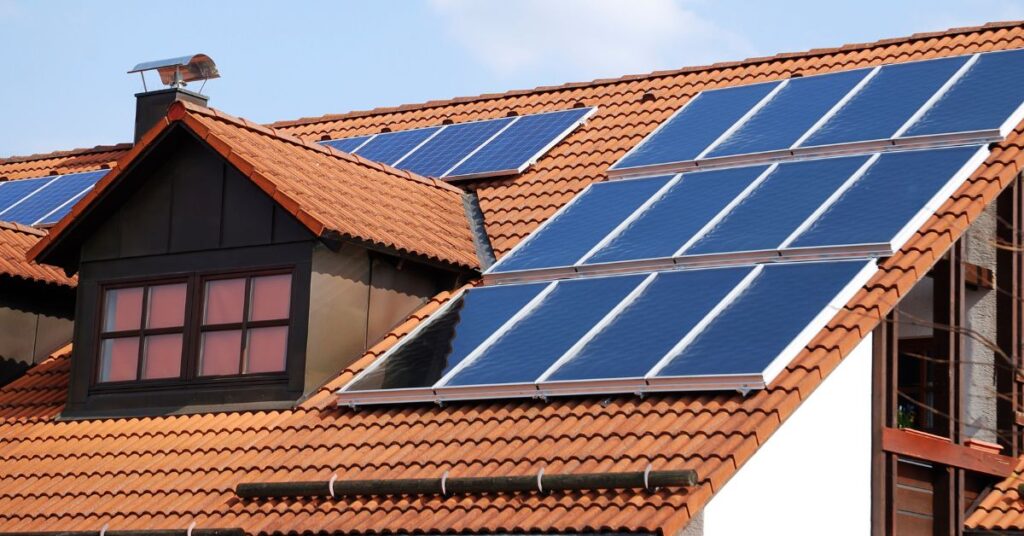
1. Reduced Energy Production
- Possible Causes: Dirty panels, shading from trees, inverter malfunction, or poor weather conditions
- Action: Clean the panels and check the inverter. Ensure that trees or other structures aren’t casting shadows on the panels, and monitor production during different weather conditions.
2. Inverter Errors
- Possible Causes: Loose connections, faulty wiring, or overheating
- Action: Check for visible signs of wear on the wiring. If the inverter has an error message, consult the manufacturer’s manual for troubleshooting tips or contact a technician.
3. Unusual Noises
- Possible Causes: Loose racking or panel mounts, loose wiring, or debris lodged in the panels
- Action: Inspect the panels and mounting system for any visible issues. If you can’t identify the source of the noise, call a professional for a more thorough inspection.
4. Water Damage or Leaks
- Possible Causes: Roof deterioration, improper sealing around the panel mounts
- Action: Have a roofer inspect the area around the panels for leaks or water damage. Repair any roofing issues promptly to prevent further damage.
Maintenance Checklist for Rooftop Solar Systems
Use this checklist to ensure your rooftop solar system remains in optimal condition.
Quarterly Tasks
- Clean solar panels with a soft brush and soapy water.
- Inspect panels for visible damage (cracks, chips).
- Check for any shading issues (trees, structures).
- Inspect wiring for wear or fraying.
- Examine mounting system for signs of corrosion or loose hardware.
- Monitor energy output via app or inverter display.
Semi-Annual Tasks
- Check the inverter for any error messages or warning lights.
- Inspect the roof for leaks or signs of deterioration near the panels.
- Clear debris around the roof (leaves, branches).
Annual Tasks
- Schedule a professional inspection of electrical components and wiring.
- Have a roofing contractor inspect the structural integrity of the roof.
- Review system performance over the past year and compare it with expectations.
- Update your monitoring system or software if needed to ensure continued access to data.
FAQs About Maintenance and Repair of Rooftop Solar Systems A Guide and Checklist
Maintaining and repairing your rooftop solar system is essential for maximizing efficiency, ensuring safety, and prolonging its lifespan. By performing regular maintenance tasks and addressing small issues promptly, you can avoid costly repairs and ensure that your system provides clean energy for years to come. Whether you choose to tackle basic maintenance yourself or hire a professional for more complex tasks, keeping an eye on your system’s performance is the key to long-term success. Use the guide and checklist provided to stay on top of your solar system’s care, ensuring that your investment continues to pay off.
Click here to learn more about How to Use and Store The Excess Solar Power
